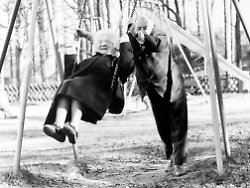Friday December 31, 2021
DRV boss takes stock
“Disaster scenarios” for the pension are unfounded
In view of the aging society, many consider the pay-as-you-go pension system in Germany to be unsustainable. But a look at the past 65 years shows that the statutory pension has already mastered major upheavals.
Despite an aging society in Germany, black paint is inappropriate in the debate about future pensions from the perspective of the pension insurance. “Looking ahead to the next few years, there is no reason for catastrophe scenarios, because we are dealing with long-term, assessable processes without sudden interruptions,” said the President of the Pension Insurance, Gundula Roßbach. That shows the view of the longer development, said Roßbach on the occasion of a pension anniversary at the beginning of the year.
In January 1957, the first major pension reform since World War II was passed in the Bundestag. It came into effect retrospectively on January 1st. Federal Chancellor Konrad Adenauer had pushed through a reorganization of the statutory pension against resistance from the business associations and objections from the finance and economics ministries. Since then, pensions have been geared towards general wage developments and made dynamic. Previously, the benefits were not adjusted to the wage development and were based on a unit amount plus a small increase amount.
“During that time we have seen that we can manage differently in a pay-as-you-go system than in a funded system,” said Roßbach. “The pensions are paid on a pay-as-you-go basis from the current contributions and not after a phase of capital building.” That makes the pension insurance adaptable – this is how the pension insurance coped well with the reunification and the financial crisis. “Now pension insurance is an anchor of stability in the pandemic.”
Criticism from employers
Roßbach said: “If we factor out inflation, our standard pension today is two and a half times what it was when the pay-as-you-go pension was introduced in 1957.” The standard pension is obtained after 45 years of average earnings with corresponding contributions. “Between 2010 and 2020 alone, the average old-age pension rose by over 30 percent,” said Roßbach. “So that was really dynamic.”
The DRV President also pointed out that the contribution rate is lower today than it was in the mid-1980s. A lot has already changed demographically: In 1985 there were 24 people aged 65 and over for every 100 people between the ages of 20 and 65. Today there are 37. “Pension insurance ensures that people also participate in economic performance in old age,” emphasized Roßbach. “In the past few decades, far-reaching reforms have taken place in pension insurance in order to respond to demographic developments,” said the DRV President. “And in the future too, pension insurance will adapt to changing demographic, social and economic conditions.”
At the turn of the year, leading employer representatives had accused the Ampelkoalition of a lack of willingness to reform pensions. Employer President Rainer Dulger had spoken of a “complete blind flight” with regard to future financial developments due to the impending retirement of baby boomers with high birth rates. Crafts President Hans Peter Wollseifer warned against higher contributions or even higher subsidies through the federal budget.
